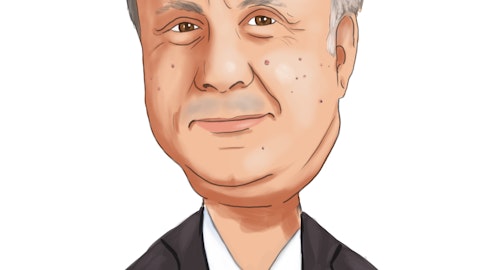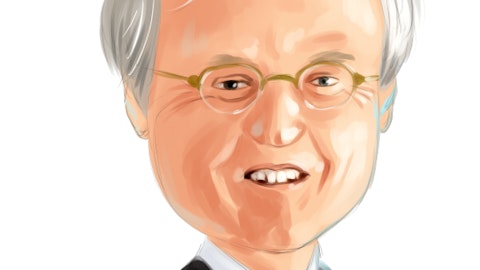Peter Ho: Thanks.
Operator: Our next question comes from Jeff Rulis with D.A. Davidson. Your line is now open.
Jeff Rulis: Thanks. Good morning.
Peter Ho: Hi, Jeff.
Jeff Rulis: Just a follow-on, I guess, to that last one, Peter, I — on the beta, I’m just interested in your thoughts. It sounds like maybe Q4 wasn’t the total acceleration or a catch-up quarter. I would have assumed much of the rate hikes we’ve had and the rate-sensitive, customers have kind of rushed to the gate and dealt with that. I guess, your expectation is that, that just continues to drift into the beta, and as we get into 2023, you see additional pressure there? Maybe more succinctly, you don’t think Q4 was a catch-up quarter and would expect further pressure from here?
Peter Ho: I would. I think that — yes, I mean, there’s — I think when we step back and look at it, it’s really quite amazing how suddenly and how quickly rates moved. I mean, basically, it was really mostly a second half of 2022 phenomena. And candidly, our strategy into the teeth of that was to be pretty conservative around our betas and our pricing, because given our market position in the deposit markets we serve, we thought that would frankly just be the best course as we kind of widen out into a little bit more experience and what we’re seeing from a rate volume standpoint. I thought that quarter’s deposit performance was okay. Frankly, I’d like to get to flat to slightly up and that may require some additional pricing.
So that’s what — certainly you may see that on the NIM and hopefully — our hope would be to see — would be able to offset that price erosion on NII by volume increases. But I would point out that the NII could very well drift down a bit in the coming quarters. I don’t think that would be a overly pessimistic view.
Jeff Rulis: Yes. Okay. So, there’s definitely a balance — deposit balance part of the equation. Fair enough. Wanted to also pivot to the visitor count. And I guess as you look at the numbers, sort of a little bit slowing at the domestic and lifting of Japan and international. I guess kind of suggesting settling more towards long-term kind of run rates that may be oversimplifying, but always interested, Peter, in your take on kind of where we’re headed and kind of how those trends play out into 2023?
Peter Ho: Right. So, overall, I’d say that the visitor industry is, I think, kind of hodgepodge its way into a pretty good year in ’22. Basically the U.S. market has over performed both by volumes as well as by spending — arrival volumes and spending. Japan is coming back slowly. So, when I look at November numbers, year-to-date, Japan was down 89%, but for the month of November, they’re down in the 70%-s. So, there is some moderating improvement there. And then, I guess what I would say is the other — Japan is a big chunk of international, which is about a third of our visitor business. The other markets, Canada, Australia, some of the other foreign countries, are beginning to form quite a bit better. So, they may be better than the Japanese experience by, call it, half.
So, the overall, the bottom lines of the visitor segment has been generally positive, I’d say, to pre-pandemic levels. That’s been led by kind of outsized U.S. domestic. Potentially as that begins to fall off a bit as the economy cools, we’re hoping to see that infilled by an improvement in Japanese and other international visitors, but we’ll see, it’s been a slow rise for Japan.
Jeff Rulis: Okay. Thank you. And maybe just last housekeeping. Dean, I missed the — could you repeat the contra expense on the Visa front? You mentioned $600,000. Is that for the year, by the quarter?
Dean Shigemura: It’s for the first quarter — in the first quarter.
Jeff Rulis: And then, not to recur, or just a one quarter event?
Dean Shigemura: Well, I mean, we — in the third quarter, there was a one — and I think in the first quarter of last year, I would like to say it’s one-time, but it’s just dependent on how Visa manages that.
Peter Ho: It’s the mark on Visa.
Dean Shigemura: Yes. It’s the mark on Visa.
Jeff Rulis: Got it. Okay. Thank you.
Peter Ho: Thanks, Jeff.
Operator: Our next question comes from Laurie Hunsicker with Compass Point. Your line is now open.
Laurie Hunsicker: Great. Hi, thanks. Good morning.
Peter Ho: Hey, Laurie.
Laurie Hunsicker: Just wanted to circle back to maybe where Kelly and Drew and Jeff were touching on net interest income, but I just wanted potentially to drill down a little bit more on the funding here. Can you talk about how you’re thinking about borrowings a massive uptick this quarter? It’s still obviously very small relative to your liabilities. But, I guess, point number one, sitting at $410 million, how should we think about that going forward? Because those are higher costing. And then, number two, just on the public deposits, obviously, there was a jump there. Do you have the breakdown on what part of that is time? And then, number three, can you comment on the noninterest-bearing? So, your noninterest-bearing average balances dropped a lot. Can you help us think about that going forward? Was that just an anomaly in the quarter, or just maybe help us think a little bit about that? Thanks.





